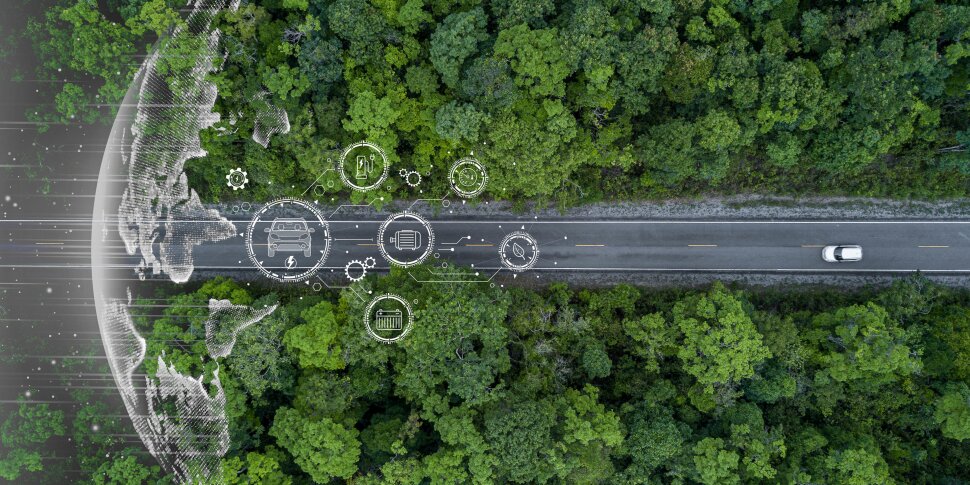Urban Green Spaces and Quality of Life Among Young Adults: Moderating Effects of Loneliness
Downloads
This research study aims to explore whether urban green spaces (UGS) correlate with the quality of life (QOL) and whether loneliness (LL) can influence this relationship among young adults in the Monterrey metropolitan area of Mexico. The study employed quantitative methods, using both online and paper surveys in Spanish and English to collect 182 valid responses, which were analyzed through statistical techniques such as reliability, validity, correlation, and moderation analysis. The results indicated that UGS are significantly and positively related to QOL (β=0.20, p≤0.01). Furthermore, the study found that LL has a significant negative related to QOL (β=-0.09, p≤0.05). Results also demonstrate a significant negative moderation effect of LL on UGS and QOL (β=-0.13, p≤0.05). With the findings, we propose that urban planners and policymakers prioritize developing and maintaining UGS to enhance citizens' QOL. Furthermore, efforts should be made to reduce LL by involving citizens in community participation to increase a sense of community and place attachment. This study offers new insights into the relationship between UGS, LL, and QOL, highlighting the significance of social connections in maximizing the benefits of green spaces on quality of life.
Downloads
[1] Ritchie, H., Rodés-Guirao, L., Mathieu, E., Gerber, M., Ortiz-Ospina, E., Hasell, J., & Roser, M. (2023). Population growth. Our World in Data, Global Change Data Lab, University of Oxford, Oxford, United Kingdom. Available online: https://ourworldindata.org/population-growth?insight=the-rapid-progress-seen-in-many-countries-shows-an-end-to-poverty-is-possible#article-citation (accessed on August 2025).
[2] World Bank Group. (2015). Urban Development. World Bank Group, Washington, United States. Available online: https://www.worldbank.org/en/topic/urbandevelopment/overview#1 (accessed on August 2025).
[3] Elmqvist, T., Fragkias, M., Goodness, J., Güneralp, B., Marcotullio, P. J., McDonald, R. I., Parnell, S., Schewenius, M., Sendstad, M., Seto, K. C., & Wilkinson, C. (2013). Urbanization, Biodiversity and Ecosystem Services: Challenges and Opportunities. Springer, Dordrecht, Netherlands. doi:10.1007/978-94-007-7088-1.
[4] Milgram, S. (1970). The experience of living in cities. Science, 167(3924), 1461–1468. doi:10.1126/science.167.3924.1461.
[5] Rybski, D., & González, M. C. (2022). Cities as complex systems—Collection overview. PLoS One, 17(2), 262964. doi:10.1371/journal.pone.0262964.
[6] UNESA. (2015). the 17 Goals. Department of Economic and Social Affairs, Sustainable Development, United Nations, New York, united States. Available online: https://sdgs.un.org/goals (accessed on August 2025).
[7] Sette Whitaker Ferreira, J., Rojas, E., De Souza Carvalho, H. R., Rago Frignani, C., & Santi Lupo, L. (2020). Housing policies and the roles of local governments in Latin America: recent experiences. Environment and Urbanization, 32(2), 333–350. doi:10.1177/0956247820935699.
[8] Instituto Nacional de Estadística y Geografía (INEGI). (2023). Use statistics and geography to discover Mexico. Instituto Nacional de Estadística y Geografía (INEGI), Aguascalientes, Mexico. Available online: https://cuentame.inegi.org.mx/poblacion/rur_urb.aspx?tema=P (accessed on August 2025). (In Spanish).
[9] Diario Oficial de la Federación (DOF). (2023). Rules of Operation of the Urban Improvement Program for Fiscal Year 2024. Diario Oficial de la Federación (DOF), Cuauhtémoc, Mexico. Available online: https://www.dof.gob.mx/nota_detalle.php?codigo=5713381&fecha=30/12/2023 (accessed on August 2025). (In Spanish).
[10] Political Constitution of the United Mexican States. (2024). Chamber of Deputies of the H. Congress of the Union. Political Constitution of the United Mexican States, Santiago de Querétaro, Mexico. Available online: https://www.diputados.gob.mx/LeyesBiblio/pdf/CPEUM.pdf (accessed on August 2025). (In Spanish).
[11] Ismail, W. A. W., & Said, I. (2015). Integrating the Community in Urban Design and Planning of Public Spaces: A Review in Malaysian Cities. Procedia - Social and Behavioral Sciences, 168, 357–364. doi:10.1016/j.sbspro.2014.10.241.
[12] Muhammad, Z. (2016). Improving Quality of Life through Community-based Participatory Development in Nigeria: Explanatory Factors for Success and Failure. Procedia - Social and Behavioral Sciences, 222, 151–159. doi:10.1016/j.sbspro.2016.05.206.
[13] van Bommel, M. N. C., Derkzen, M. L., & Vaandrager, L. (2025). Greening for meaning: Sense of place in green citizen initiatives in the Netherlands. Wellbeing, Space and Society, 8(100240), 100240. doi:10.1016/j.wss.2025.100240.
[14] Hu, J., Zhang, F., Qiu, B., Zhang, X., Yu, Z., Mao, Y., Wang, C., & Zhang, J. (2024). Green-gray imbalance: Rapid urbanization reduces the probability of green space exposure in early 21st century China. Science of the Total Environment, 933(173168), 173168. doi:10.1016/j.scitotenv.2024.173168.
[15] Jamalishahni, T., Turrell, G., Foster, S., Davern, M., & Villanueva, K. (2023). Neighbourhood socio-economic disadvantage and loneliness: the contribution of green space quantity and quality. BMC Public Health, 23(1), 598. doi:10.1186/s12889-023-15433-0.
[16] Villeneuve, P. J., Gill, G. K., Cottagiri, S. A., Dales, R., Rainham, D., Ross, N. A., Dogan, H., Griffith, L. E., Raina, P., & Crouse, D. L. (2024). Does urban greenness reduce loneliness and social isolation among Canadians? A cross-sectional study of middle-aged and older adults of the Canadian Longitudinal Study on Aging (CLSA). Canadian Journal of Public Health, 115(2), 282–295. doi:10.17269/s41997-023-00841-x.
[17] Chavis, D. M., & Wandersman, A. (1990). Sense of community in the urban environment: A catalyst for participation and community development. American Journal of Community Psychology, 18(1), 55–81. doi:10.1007/BF00922689.
[18] Manzo, L. C., & Perkins, D. D. (2006). Finding common ground: The importance of place attachment to community participation and planning. Journal of Planning Literature, 20(4), 335–350. doi:10.1177/0885412205286160.
[19] Budruk, M., Thomas, H., & Tyrrell, T. (2009). Urban green spaces: A study of place attachment and environmental attitudes in India. Society & Natural Resources, 22(9), 824–839. doi:10.1080/08941920802628515.
[20] Dinnie, E., Brown, K. M., & Morris, S. (2013). Community, cooperation and conflict: Negotiating the social well-being benefits of urban greenspace experiences. Landscape and Urban Planning, 112(1), 1–9. doi:10.1016/j.landurbplan.2012.12.012.
[21] Li, J., Koohsari, M. J., Kaczynski, A. T., Tanimoto, R., Watanabe, R., Nakaya, T., Luo, Y., Zhao, J., Yasunaga, A., Oka, K., & Hanibuchi, T. (2025). The built environment and place attachment: Insights from Japanese cities. Preventive Medicine Reports, 50(102969), 102969. doi:10.1016/j.pmedr.2025.102969.
[22] Avalle, M., Di Marco, N., Etta, G., Sangiorgio, E., Alipour, S., Bonetti, A., Alvisi, L., Scala, A., Baronchelli, A., Cinelli, M., & Quattrociocchi, W. (2024). Persistent interaction patterns across social media platforms and over time. Nature, 628(8008), 582–589. doi:10.1038/s41586-024-07229-y.
[23] Hatamleh, I. H. M. (2024). Exploring the Multifaceted Influences of Social Media Motivation on Online Relationship Commitment among Young Adults in Jordan: An Empirical Study. Human Behavior and Emerging Technologies, 2024, 1–16. doi:10.1155/2024/2510500.
[24] Askarizad, R., & Safari, H. (2020). The influence of social interactions on the behavioral patterns of the people in urban spaces (case study: The pedestrian zone of Rasht Municipality Square, Iran). Cities, 101(102687), 102687. doi:10.1016/j.cities.2020.102687.
[25] Bonsaksen, T., Ruffolo, M., Price, D., Leung, J., Thygesen, H., Lamph, G., Kabelenga, I., & Geirdal, A. Ø. (2023). Associations between social media use and loneliness in a cross-national population: do motives for social media use matter? Health Psychology and Behavioral Medicine, 11(1), 2158089. doi:10.1080/21642850.2022.2158089.
[26] Sasaki, N., Tabuchi, T., Okubo, R., & Nishi, D. (2023). Association of living condition using urbanisation level and neighbourhood deprivation with loneliness and social isolation during COVID-19 pandemic: a cross-sectional study of the nationwide data in Japan. BMJ Public Health, 1(1), e000341. doi:10.1136/bmjph-2023-000341.
[27] Twenge, J. M., Haidt, J., Blake, A. B., McAllister, C., Lemon, H., & Le Roy, A. (2021). Worldwide increases in adolescent loneliness. Journal of Adolescence, 93(1), 257–269. doi:10.1016/j.adolescence.2021.06.006.
[28] Surkalim, D. L., Luo, M., Eres, R., Gebel, K., Van Buskirk, J., Bauman, A., & Ding, D. (2022). The prevalence of loneliness across 113 countries: Systematic review and meta-analysis. The BMJ, 376, 67068. doi:10.1136/bmj-2021-067068.
[29] Jeste, D. V., Lee, E. E., & Cacioppo, S. (2020). Battling the Modern Behavioral Epidemic of Loneliness: Suggestions for Research and Interventions. JAMA Psychiatry, 77(6), 553–554. doi:10.1001/jamapsychiatry.2020.0027.
[30] Ahuja, P., Syal, G., & Kaur, A. (2021). Psychological stress: Repercussions of COVID-19 on gender. Journal of Public Affairs, 21(4). doi:10.1002/pa.2533.
[31] Ernst, M., Niederer, D., Werner, A. M., Czaja, S. J., Mikton, C., Ong, A. D., Rosen, T., Brähler, E., & Beutel, M. E. (2022). Loneliness Before and During the COVID-19 Pandemic: A Systematic Review With Meta-Analysis. American Psychologist, 77(5), 660–677. doi:10.1037/amp0001005.
[32] Carpio, A., Ponce-Lopez, R., & Lozano-García, D. F. (2021). Urban form, land use, and cover change and their impact on carbon emissions in the Monterrey Metropolitan area, Mexico. Urban Climate, 39, 100947. doi:10.1016/j.uclim.2021.100947.
[33] Cacioppo, J. T., & Cacioppo, S. (2018). Loneliness in the modern age: An evolutionary theory of loneliness (ETL). Advances in experimental social psychology, Academic press, Cambridge, United States. doi:10.1016/bs.aesp.2018.03.003.
[34] Xu, Z., Marini, S., Mauro, M., Maietta Latessa, P., Grigoletto, A., & Toselli, S. (2025). Associations Between Urban Green Space Quality and Mental Wellbeing: Systematic Review. Land, 14(2), 381. doi:10.3390/land14020381.
[35] Reyes-Riveros, R., Altamirano, A., De La Barrera, F., Rozas-Vásquez, D., Vieli, L., & Meli, P. (2021). Linking public urban green spaces and human well-being: A systematic review. Urban Forestry and Urban Greening, 61, 127105. doi:10.1016/j.ufug.2021.127105.
[36] Yu, Z., Yang, G., Zuo, S., Jørgensen, G., Koga, M., & Vejre, H. (2020). Critical review on the cooling effect of urban blue-green space: A threshold-size perspective. Urban Forestry & Urban Greening, 49, 126630. doi:10.1016/j.ufug.2020.126630.
[37] Artmann, M., Chen, X., Iojă, C., Hof, A., Onose, D., Poniży, L., Lamovšek, A. Z., & Breuste, J. (2017). The role of urban green spaces in care facilities for elderly people across European cities. Urban Forestry & Urban Greening, 27, 203–213. doi:10.1016/j.ufug.2017.08.007.
[38] Habibi, S., & Asadi, N. (2011). Causes, results and methods of controlling urban sprawl. Procedia Engineering, 21, 133–141. doi:10.1016/j.proeng.2011.11.1996.
[39] Haaland, C., & van den Bosch, C. K. (2015). Challenges and strategies for urban green-space planning in cities undergoing densification: A review. Urban Forestry & Urban Greening, 14(4), 760–771. doi:10.1016/j.ufug.2015.07.009.
[40] Wosiek, M. (2020). Rural-Urban divide in human capital in Poland after 1988. Oeconomia Copernicana, 11(1), 183–201. doi:10.24136/oc.2020.008.
[41] Dinda, S., Das Chatterjee, N., & Ghosh, S. (2021). An integrated simulation approach to the assessment of urban growth pattern and loss in urban green space in Kolkata, India: A GIS-based analysis. Ecological Indicators, 121, 107178. doi:10.1016/j.ecolind.2020.107178.
[42] Setiowati, R., & Koestoer, R. H. (2024). Valuation of Urban Green Open Spaces Using the Life Satisfaction Approach. Civil Engineering Journal, 10(4), 1159–1181. doi:10.28991/CEJ-2024-010-04-010.
[43] Kahn, M. E. (2009). Urban Growth and Climate Change. Annual Review of Resource Economics, 1(1), 333–350. doi:10.1146/annurev.resource.050708.144249.
[44] Gehl, J. (2006). The Humanization of Urban Space: Social Life Between Buildings. Editorial Reverté, Barcelona. Spain. (In Spanish).
[45] Francis, J., Giles-Corti, B., Wood, L., & Knuiman, M. (2012). Creating sense of community: The role of public space. Journal of Environmental Psychology, 32(4), 401–409. doi:10.1016/j.jenvp.2012.07.002.
[46] Clark, L. F. (1993). Stress and the Cognitive-Conversational Benefits of Social Interaction. Journal of Social and Clinical Psychology, 12(1), 25–55. doi:10.1521/jscp.1993.12.1.25.
[47] Brueckner, J. K., & Largey, A. G. (2008). Social interaction and urban sprawl. Journal of Urban Economics, 64(1), 18–34. doi:10.1016/j.jue.2007.08.002.
[48] Lynch, K. (1960). The Image of the City. MIT Press, Cambridge, United States.
[49] Beere, P., Keeling, S., & Jamieson, H. (2019). Ageing, loneliness, and the geographic distribution of New Zealand’s interRAI-HC cohort. Social Science & Medicine, 227, 84–92. doi:10.1016/j.socscimed.2018.08.002.
[50] Lim, M. H., Eres, R., & Vasan, S. (2020). Understanding loneliness in the twenty-first century: an update on correlates, risk factors, and potential solutions. Social Psychiatry and Psychiatric Epidemiology, 55(7), 793–810. doi:10.1007/s00127-020-01889-7.
[51] Twenge, J. M., Spitzberg, B. H., & Campbell, W. K. (2019). Less in-person social interaction with peers among U.S. adolescents in the 21st century and links to loneliness. Journal of Social and Personal Relationships, 36(6), 1892–1913. doi:10.1177/0265407519836170.
[52] Khalaf, A. M., Alubied, A. A., Khalaf, A. M., & Rifaey, A. A. (2023). The Impact of Social Media on the Mental Health of Adolescents and Young Adults: A Systematic Review. Cureus, 15(8), 42990. doi:10.7759/cureus.42990.
[53] Mathie, A., & Cunningham, G. (2003). From clients to citizens: Asset-based Community Development as a strategy for community-driven development. Development in Practice, 13(5), 474–486. doi:10.1080/0961452032000125857.
[54] Tsahor, M., Katoshevski-Cavari, R., & Alfasi, N. (2023). Assessing urban adaptability: The key is in the land use plan. Land Use Policy, 126, 106508. doi:10.1016/j.landusepol.2022.106508.
[55] Ma, B., Zhou, T., Lei, S., Wen, Y., & Htun, T. T. (2019). Effects of urban green spaces on residents’ well-being. Environment, Development and Sustainability, 21(6), 2793–2809. doi:10.1007/s10668-018-0161-8.
[56] Sun, Y., Xie, S., & Zhao, S. (2019). Valuing urban green spaces in mitigating climate change: A city-wide estimate of aboveground carbon stored in urban green spaces of China’s Capital. Global Change Biology, 25(5), 1717–1732. doi:10.1111/gcb.14566.
[57] Das, D. (2008). Urban quality of life: A case study of Guwahati. Social Indicators Research, 88(2), 297–310. doi:10.1007/s11205-007-9191-6.
[58] Barber, A., Haase, D., & Wolff, M. (2021). Permeability of the city – Physical barriers of and in urban green spaces in the city of Halle, Germany. Ecological Indicators, 125, 107555. doi:10.1016/j.ecolind.2021.107555.
[59] Kothencz, G., Kolcsár, R., Cabrera-Barona, P., & Szilassi, P. (2017). Urban green space perception and its contribution to well-being. International Journal of Environmental Research and Public Health, 14(7), 766. doi:10.3390/ijerph14070766.
[60] Wesz, J. G. B., Miron, L. I. G., Delsante, I., & Tzortzopoulos, P. (2023). Urban Quality of Life: A Systematic Literature Review. Urban Science, 7(2), 56. doi:10.3390/urbansci7020056.
[61] Einav, M., & Margalit, M. (2023). Loneliness before and after COVID-19: Sense of Coherence and Hope as Coping Mechanisms. International Journal of Environmental Research and Public Health, 20(10), 5840. doi:10.3390/ijerph20105840.
[62] Prescott, S. L. (2023). Lost Connections: Why the Growing Crisis of Loneliness Matters for Planetary Health. Challenges, 14(3), 31. doi:10.3390/challe14030031.
[63] Shankar, A., Rafnsson, S. B., & Steptoe, A. (2015). Longitudinal associations between social connections and subjective wellbeing in the English Longitudinal Study of Ageing. Psychology & Health, 30(6), 686–698. doi:10.1080/08870446.2014.979823.
[64] Pasanen, T. P., White, M. P., Elliott, L. R., van den Bosch, M., Bratman, G. N., Ojala, A., Korpela, K., & Fleming, L. E. (2023). Urban green space and mental health among people living alone: The mediating roles of relational and collective restoration in an 18-country sample. Environmental Research, 232, 116324. doi:10.1016/j.envres.2023.116324.
[65] Conedera, M., Del Biaggio, A., Seeland, K., Moretti, M., & Home, R. (2015). Residents’ preferences and use of urban and peri-urban green spaces in a Swiss mountainous region of the Southern Alps. Urban Forestry & Urban Greening, 14(1), 139–147. doi:10.1016/j.ufug.2015.01.003.
[66] Wang, K., Frison, E., Eggermont, S., & Vandenbosch, L. (2018). Active public Facebook use and adolescents’ feelings of loneliness: Evidence for a curvilinear relationship. Journal of Adolescence, 67, 35–44. doi:10.1016/j.adolescence.2018.05.008.
[67] Cronbach, L. J. (1951). Coefficient alpha and the internal structure of tests. Psychometrika, 16(3), 297–334. doi:10.1007/BF02310555.
[68] Schober, P., & Schwarte, L. A. (2018). Correlation coefficients: Appropriate use and interpretation. Anesthesia and Analgesia, 126(5), 1763–1768. doi:10.1213/ANE.0000000000002864.
[69] Giannico, V., Spano, G., Elia, M., D’Este, M., Sanesi, G., & Lafortezza, R. (2021). Green spaces, quality of life, and citizen perception in European cities. Environmental Research, 196(110922), 110922. doi:10.1016/j.envres.2021.110922.
[70] Akpinar, A. (2016). How is quality of urban green spaces associated with physical activity and health? Urban Forestry & Urban Greening, 16, 76–83. doi:10.1016/j.ufug.2016.01.011.
[71] Zhang, Y., Van den Berg, A. E., Van Dijk, T., & Weitkamp, G. (2017). Quality over quantity: Contribution of urban green space to neighborhood satisfaction. International Journal of Environmental Research and Public Health, 14(5), 535. doi:10.3390/ijerph14050535.
[72] Bartlett, M. Y., & Arpin, S. N. (2019). Gratitude and Loneliness: Enhancing Health and Well-Being in Older Adults. Research on Aging, 41(8), 772–793. doi:10.1177/0164027519845354.
[73] Terkelsen, A. S., Gulis, G., Jespersen, J., Berg-Beckhoff, G., & Andersen, P. T. (2025). Quality of Life, Loneliness, and Social Interactions Among Older People Moving to a Senior Village: A Longitudinal Study of an Age-Friendly Community Initiative. Journal of Aging and Environment, 1–17. doi:10.1080/26892618.2025.2475436.
[74] Li, R., Yan, Q., Qu, Y., & Wang, Y. (2025). Square dance, loneliness, quality of life, and attitude toward aging in middle-aged and older women in China. Frontiers in Public Health, 13, 1508556. doi:10.3389/fpubh.2025.1508556.
[75] Binte Mohammad Adib, N. A., & Sabharwal, J. K. (2024). Experience of loneliness on well-being among young individuals: A systematic scoping review. Current Psychology, 43(3), 1965–1985. doi:10.1007/s12144-023-04445-z.
[76] Kirwan, E. M., Burns, A., O’Súilleabháin, P. S., Summerville, S., McGeehan, M., McMahon, J., Gowda, A., & Creaven, A. M. (2025). Loneliness in Emerging Adulthood: A Scoping Review. Adolescent Research Review, 10(1), 47–67. doi:10.1007/s40894-024-00240-4.
[77] Matthews, T., Danese, A., Caspi, A., Fisher, H. L., Goldman-Mellor, S., Kepa, A., Moffitt, T. E., Odgers, C. L., & Arseneault, L. (2019). Lonely young adults in modern Britain: Findings from an epidemiological cohort study. Psychological Medicine, 49(2), 268–277. doi:10.1017/S0033291718000788.
[78] Shah, H. A., & Househ, M. (2023). Understanding Loneliness in Younger People: Review of the Opportunities and Challenges for Loneliness Interventions. Interactive Journal of Medical Research, 12, e45197. doi:10.2196/45197.
[79] Musich, S., Wang, S. S., Hawkins, K., & Yeh, C. S. (2015). The Impact of Loneliness on Quality of Life and Patient Satisfaction Among Older, Sicker Adults. Gerontology and Geriatric Medicine, 1. doi:10.1177/2333721415582119.
[80] Bergefurt, L., Kemperman, A., van den Berg, P., Borgers, A., van der Waerden, P., Oosterhuis, G., & Hommel, M. (2019). Loneliness and life satisfaction explained by public-space use and mobility patterns. International Journal of Environmental Research and Public Health, 16(21), 4282. doi:10.3390/ijerph16214282.
[81] van den Berg, M. M., van Poppel, M., van Kamp, I., Ruijsbroek, A., Triguero-Mas, M., Gidlow, C., Nieuwenhuijsen, M. J., Gražulevičiene, R., van Mechelen, W., Kruize, H., & Maas, J. (2019). Do Physical Activity, Social Cohesion, and Loneliness Mediate the Association Between Time Spent Visiting Green Space and Mental Health? Environment and Behavior, 51(2), 144–166. doi:10.1177/0013916517738563.
[82] Jones, P., & Comfort, D. (2021). Placemaking and the United Kingdom’s largest housebuilders. Journal of Public Affairs, 21(2), e2458. doi:10.1002/pa.2458.
[83] Cardinali, M., Beenackers, M. A., van Timmeren, A., & Pottgiesser, U. (2023). Preferred reporting items in green space health research. Guiding principles for an interdisciplinary field. Environmental Research, 228, 115893. doi:10.1016/j.envres.2023.115893.
- The authors retain all copyrights. It is noticeable that authors will not be forced to sign any copyright transfer agreements.
- This work (including HTML and PDF Files) is licensed under a Creative Commons Attribution 4.0 International License.














